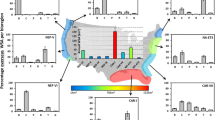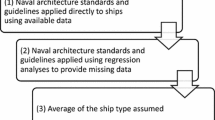Abstract
Ships’ hulls can transport aquatic nuisance species, but there is little quantitative information about the magnitude of vessel biofouling on a global or regional scale. There does not exist a robust method to estimate the wetted surface area (WSA) of a particular fleet of ships, especially across the diversity of possible vessel types. An estimate of the total WSA of ship arrivals into a port or region is essential to determine the potential scope of biofouling and to inform management strategies to reduce the future invasions. Multiple statistical models were developed so commonly available ships’ parameters could be used to estimate the WSA for a given set of fleet data. Using individual ship characteristics and publicly available data from ~120,000 active commercial ships in the world fleet, the method results in a total global minimum WSA estimate of approximately 325 × 106 m2. The size of the global fleet employed here is greater than the commonly cited vessel number of approximately 80,000–90,000, as we include ships <100 gross tons. Over 190,000 vessels were initially identified, representing a WSA of 571 × 106 m2, but active status of only 120,000 vessels could be confirmed. Reliable data were unavailable on the operating status of many additional and especially smaller vessels. This approach, along with a contemporary and comprehensive estimate of global WSA, when combined with knowledge of the different operational profiles of ships that may reduce biofouling (port residence times, steaming speeds, extent of antifouling coatings, cleaning frequency, etc.), can inform current numerical models and risk assessments of bioinvasions.




Similar content being viewed by others
References
Australian Department of Agriculture (2015) Proposed Australian biofouling management strategies, [updated 2015 Feb 25; cited 2015 Aug 4]. http://www.agriculture.gov.au/biosecurity/avm/vessels/biofouling
Baier RE, Meyer AE, DePalma VA, King RW, Fornalik MS (1983) Surface microfouling during the induction period. J Heat Transf 105:618–624
Bettelhäuser F, Ullrich P (1993) Die Suche nach dem sozial-und umweltverträglichen Schiff-Die ersten Schritte. Arbeitskreis andere nützliche Objekte der Bremer Vulkan Werft (translated):1–92
Callow JA, Callow ME (2011) Trends in the development of environmentally friendly fouling-resistant marine coatings. Commun Nat. doi:10.1038/ncomms1251
Campbell ML, Inti Keith I, Hewitt CL, Dawson TP, Collins K (2015) Evolving marine biosecurity in the Galapagos Islands. Bioinvasions Rec 6(3):227–230
Clare AS, Rittschof D, Gerhart DJ, Maki JS (1992) Molecular approaches to non-toxic antifouling. Invertebr Reprod Dev 22:67–76
Corbett JJ, Koehler HW (2003) Updated emissions from ocean shipping. J Geophys Res 108(D20):4650–4666
Coutts ADM (1999) Hull fouling as a modern vector for marine biological invasions: investigation of merchant vessels visiting northern Tasmania. Masters Thesis, Australian Maritime College, Launceston, Tasmania
Coutts ADM, Taylor MD (2004) A preliminary investigation of biosecurity risks associated with biofouling on merchant vessels in New Zealand. N Z J Mar Freshw 38:215–229
Coutts ADM, Dodgshun TJ (2007) The nature and extent of organisms in vessel sea-chests: a protected mechanism for marine bioinvasions. Mar Pollut Bull 54:875–886
Davidson IC, McCann LD, Fofonoff PW, Sytsma MD, Ruiz GM (2008) The potential for hull-mediated species transfers by obsolete ships on their final voyages. Divers Distrib 14:518–529
Davidson IC, Brown CW, Sytsma MD, Ruiz GM (2009) The role of containerships as transfer mechanisms of marine biofouling species. Biofouling 25:645–655
Decho AW (2000) Microbial biofilms in intertidal systems: an overview. Cont Shelf Res 20:1257–1273
Dobretsov S, Abed RMM, Teplitski M (2013) Mini-review: inhibition of biofouling by marine microorganisms. Biofouling 29:423–441
Endresen Ø, Sørgård E, Sundet JK, Dalsøren SB, Isaksen ISA, Berglen TF, Gravir G (2003) Emission from international sea transportation and environmental impact. J Geophys Res 108(D17):4560. doi:10.1029/2002JD002898
[EMSA] European Maritime Safety Agency (2012) The world merchant fleet 2012: statistics from Equasis. European Maritime Safety Agency, Lisbon
[FAO] Fisheries and Aquaculture Department (2007) The state of world fisheries and aquaculture 2006. Food And Agriculture Organization Of The United Nations, Rome
Floerl O, Inglis G, Dey KL, Smith A (2009) The importance of transport hubs in stepping-stone invasions. J Appl Ecol 46:37–45
Gollasch S (2002) The importance of ship hull fouling as a vector of species introductions into the North Sea. Biofouling 18(2):105–121
Hay C, Dodgshun T (1997, May) Ecosystem transplant? The case of the Yefim Gorbenko. Seafood N Z, p 13–15
Hewitt C (2002) Distribution and biodiversity of Australian tropical marine bioinvasions. Pac Sci 56:213–222
Inglis GJ, Floerl O, Ahyong S, Cox S, Unwin M, Ponder-Sutton A, Seaward K, Kospartov M, Read G, Gordon D, Hosie A, Nelson W, d’Archino R, Bell A, Kluza D (2010) The biosecurity risks associated with biofouling on international vessels arriving in New Zealand: summary of the patterns and predictors of fouling. Biosecurity New Zealand technical paper, Wellington
[IMO] International Maritime Organization (1974) UNTS 3: International convention for the safety of life at sea, vol 1184
[IMO] International Maritime Organization (2004) Convention BWM/CONF/36: international convention for the control and management of ships’ ballast water and sediments
[IMO] International Maritime Organization (2011) Resolution MEPC.207(62): guidelines for the control and management of ships’ biofouling
[IMO] Internation Maritime Organization (2012) MEPC.1/Circ.792: guidance for minimizing the transfer of invasive aquatic species as biofouling (hull fouling) for recreational craft
Jones B (1998) Infosheet 45: Lloyd’s Register/International Maritime Organisation Numbers. Lloyd’s Register Foundation Information Centre, London. [updated 2014 Jan 3; cited 2014 Nov 13]. http://www.lr.org/en/_images/213-35670_45-IMO-numbers.pdf
Lenz J, Andres HG, Gollasch S, Dammer M (2000) Einschleppung fremder organismen in Nord-und ostsee: untersuchungen zum ökologischen gefahrenpotential durch den schiffsverkehr (translated). UBA Project Water: 102 04 250, Umweltbundesamt, Berlin, Texte 5
Leung B, Drake JM, Lodge DM (2004) Predicting invasions: propagule pressure and the gravity of Allee effects. Ecology 85:1651–1660
MAN Diesel and Turbo (2011) Basic principles of ship propulsion. MAN SE, Munich
[MPI] Ministry of Primary Industries (2014) Biofouling on vessels arriving to New Zealand. CRMS-Bioufoul, Wellington
Molland AF (2011) Ship resistance and propulsion: practical estimation of propulsive power. Cambridge University Press, New York
Muirhead JR, MacIsaac HJ (2011) Evaluation of stochastic gravity model selection for use in estimating non-indigenous species dispersal and establishment. Biol Invasions 13:2445–2458
National Ballast Information Clearinghouse (2013) NBIC Online Database, Electronic publication, Smithsonian Environmental Research Center and United States Coast Guard. http://invasions.si.edu/nbic/search.html. searched 26 Aug 2013
Olesen G (1982, May) Antifouling paint—a source of pollution. Shipcare Marit Manage, p 37–41
Papahānaumokuākea Marine National Monument (2008) Papahānaumokuākea Marine National Monument Management Plan. National Oceanic and Atmospheric Administration, United States Fish and Wildlife Service, Hawaii Department of Land and Natural Resources, Honolulu
Ruiz GM, Fofonoff PW, Steves BP, Carlton JT (2015) Invasion history and vector dynamics in coastal marine ecosystems: a North American perspective. Aquat Ecosyst Health Manag 18(3):1–13
Saunders HE (1957) Hydrodynamics in ship design, vol II. The Society of Naval Architects and Marine Engineers, New York
Schneekluth H, Bertram V (1998) Ship design for efficiency and economy, 2nd edn. Butterworth-Heinemann, Oxford
Schultz MP (2007) Effects of coating roughness and biofouling on ship resistance and powering. Biofouling 23(5):331–341
Schultz MP, Swain GW (2009) The influence of biofilms on skin friction drag. Biofouling 15(1–3):129–139
Schultz MP, Bendick JA, Holm ER, Hertel WM (2011) Economic impact of biofouling on a naval surface ship. Biofouling 27(1):87–98
Shikuma NJ, Hadfield MG (2005) Temporal variation of an initial marine biofilm community and its effects on larval settlement and metamorphosis of the tubeworm Hydroides elegans. Biofilms 2:231–238
U.S. Census Bureau (2010) Census 2010, state and county QuickFacts. [updated 2015 May 28; cited 2015 Aug 10]. http://quickfacts.census.gov/qfd/states/11000.html
U.S. Energy Information Administration (2014) Annual energy outlook 2014. U.S. Department of Energy, Washington (DC)
Visscher JP (1928) Nature and extent of fouling of ships’ bottoms. Bull US Bur Fish 43:193–252
Zobell CE (1943) The effect of solid surfaces upon bacterial activity. J Bacteriol 46:39–56
Acknowledgments
This work was supported by the University of Maryland Center for Environmental Science (funding agreement 2012–38) and the U.S. Maritime Administration (MARAD). We thank Carolyn Junemann (MARAD) for guidance and programmatic support and Mark Minton (Smithsonian Environmental Research Center) for his advice with shipping data. We appreciate advice from Rich Everett (U.S. Coast Guard) and the data provided from the National Ballast Information Clearinghouse. This work was supported by Diane Lysogorski, Section Head of NRL Code 6136 and Director of the Center for Corrosion Science and Engineering—Key West, Florida. Finally, the reviews of this manuscript by Stephanie Robbins-Wamsley, Diane Lysogorski, Edward Lemieux (Branch Head, Code 6130), Barry Spargo (Acting Superintendent, Chemistry Division, Naval Research Laboratory), Jim Carlton, and three anonymous reviewers improved it—thank you.
Author information
Authors and Affiliations
Corresponding author
Rights and permissions
About this article
Cite this article
Moser, C.S., Wier, T.P., Grant, J.F. et al. Quantifying the total wetted surface area of the world fleet: a first step in determining the potential extent of ships’ biofouling. Biol Invasions 18, 265–277 (2016). https://doi.org/10.1007/s10530-015-1007-z
Received:
Accepted:
Published:
Issue Date:
DOI: https://doi.org/10.1007/s10530-015-1007-z




